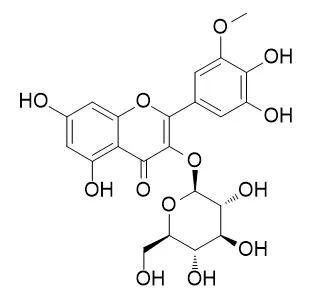| In vitro: |
| J Agric Food Chem. 2009 Jan 14;57(1):209-19. | | Flavonol 3-O-glycosides series of Vitis vinifera Cv. Petit Verdot red wine grapes.[Pubmed: 19061313 ] | Petit Verdot grape skins by solid-phase extraction using a combination of reverse-phase and ion-exchanging materials. This procedure allowed us to separate a fraction of anthocyanin-free flavonol 3-O-glycosides that was further split into neutral and acidic subfractions, thus facilitating flavonol identification.
METHODS AND RESULTS:
By means of semipreparative reverse-phase high-performance liquid chromatography, we isolated several of these flavonol 3-O-glycosides for structural elucidation. The identification of different flavonol 3-O-glycosides was based on liquid chromatography-diode array detection-electrospray ionization-tandem mass spectrometry and NMR data when available.
CONCLUSIONS:
The results suggest that red grape flavonol 3-O-glycosides comprise three different complete series, according to the nature of the sugar moiety linked to the C-3 position. The 3-O-glucosides were the main derivative of the six possible flavonol aglycones (kaempferol, quercetin, isorhamnetin, myricetin, laricitrin, and syringetin), whereas the 3-O-galactoside derivatives were found as minor compounds for all of the flavonol aglycones. The 3-O-glucuronides are the third kind of red grape flavonol derivatives and normally account as minor compounds for all of the flavonol aglycones, with the exception of quercetin 3-O-glucuronide, which was as abundant as quercetin 3-O-glucoside. In addition, the presence of quercetin 3-O-(6"-rhamnosyl)-glucoside (rutin) was also detected as a trace compound in the skins of Petit Verdot grapes. | | Molecules. 2012 Jul 25;17(8):8804-21. | | Comparison on phenolic compounds and antioxidant properties of cabernet sauvignon and merlot wines from four wine grape-growing regions in China.[Pubmed: 22832882 ] |
METHODS AND RESULTS:
The antioxidant activities in the Cabernet Sauvignon and Merlot wines from four wine grape-growing regions in China were measured by different analytical assays: 2,2-diphenyl-1-picrylhydrazyl (DPPH·), cupric reducing antioxidant capacity (CUPRAC), superoxide radical-scavenging activity (SRSA) and the contents of total phenols, total flavonoids, total flavanols and total anthocyanins were determined. The results showed that the contents of phenolic compounds and the levels of antioxidant activity in the wine samples greatly varied with cultivar and environmental factors of vine growth. The contents of phenolic compounds and antioxidant activities in Cabernet Sauvignon and Merlot wines from the Yuquanying region of Ningxia were significantly higher than other three regions, followed by the wines from Shacheng region of Hebei, and these parameters were the lowest in Cabernet Sauvignon and Merlot wines from the Changli regions of Hebei and Xiangning region of Shanxi.
CONCLUSIONS:
Taken together, a close relationship between phenolic subclasses and antioxidant activity was observed for the wine samples. Moreover, there were significant discrepancies in the individual phenolic composition and content of four regional Cabernet Sauvignon and Merlot wines, among which the individual phenolic compounds (catechin, epicatechin, cinnamic acid, quercetin-3-O-glucuronide, quercetin-3-O-glucoside, Laricitrin 3-O-glucoside and isorhamnetin-3-O-glucoside) revealed a significant correlation (p < 0.05) with the antioxidant capacity in present study, especially for catechin and epicatechin. |
|






 Cell. 2018 Jan 11;172(1-2):249-261.e12. doi: 10.1016/j.cell.2017.12.019.IF=36.216(2019)
Cell. 2018 Jan 11;172(1-2):249-261.e12. doi: 10.1016/j.cell.2017.12.019.IF=36.216(2019) Cell Metab. 2020 Mar 3;31(3):534-548.e5. doi: 10.1016/j.cmet.2020.01.002.IF=22.415(2019)
Cell Metab. 2020 Mar 3;31(3):534-548.e5. doi: 10.1016/j.cmet.2020.01.002.IF=22.415(2019) Mol Cell. 2017 Nov 16;68(4):673-685.e6. doi: 10.1016/j.molcel.2017.10.022.IF=14.548(2019)
Mol Cell. 2017 Nov 16;68(4):673-685.e6. doi: 10.1016/j.molcel.2017.10.022.IF=14.548(2019)